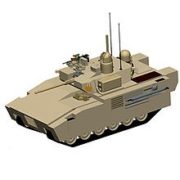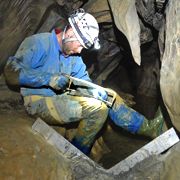Everyone knows that unmanned systems will change everything for land forces. However, no one is sure what those changes will be.
“It is, of course, impossible to predict exactly how the Landpower robot revolution will unfold.”
The above quote was written by Dr. Steven Metz, the Director of Research at the Strategic Studies Institute (SSI) as well as research director for the Joint Strategic Landpower Task Force. While the future is unknown, Dr. Metz argues that it is possible to identify the questions that need to be answered, at least some of them. Writing on SSI’s websites, his questions include:
- What is the appropriate mix of humans and robots?
- How autonomous should the robots be?
- What type of people will be needed for robot heavy Landpower formations?
- What effect will robot centric Landpower have on American national security policy?
- What to do about enemy robots?
Dr. Metz’s article is worth reading in its entirety (view it here). Below are a few highlights as well as some reactions.
Logistics and expense
Dr. Metz quotes Paul Scharre of the Center for a New American Security:
“Uninhabited systems can help bring mass back to the fight by augmenting human-inhabited combat systems with large numbers of lower cost uninhabited systems to expand the number of sensors and shooters in the fight. Because they can take more risk without a human onboard, uninhabited systems can balance survivability against cost, affording the ability to procure larger numbers of systems.”
Unmanned systems have always been seen as economical force multipliers. However, Metz’s and Scharre’s comments imply other benefits as well.
A central weakness of an army is its need for support. Even Israel’s relatively small military, which usually has short logistics lines, is vulnerable. In the run-up to the 1973 war, Egypt quickly mobilized and demobilized its forces over and over. Israel responded with its own mobilization and demobilization of its civilian-based military forces, but this played havoc with its economy. After a while, they decided that Egypt was just playing games with them; that’s when Egypt attacked.
If the military forces had been unmanned systems, Egypt’s strategy may not have been as effective. The costs of maintaining a large unmanned force in readiness may be less than mobilizing a large manned one.
Current events validate this way of thinking. The current administration is reducing manpower overseas, while relying more and more on Unmanned Aerial Vehicles (UAV). Although most people focus on the reduced risk to American lives, it is also clear that it is cheaper to send UAVs to Waziristan than maintain forward placed personnel.
A counterpoint is that robots may not be as cheap as people think they are. Douglas Barrie, Senior Fellow for Military Aerospace at the International Institute for Strategic Studies in London wrote:
“The other element of the UAV side in the ISR arena is that people look at a UAV and think, unmanned, surely it won’t cost as much. The UAV actually just shifts to some extent, where the cost comes, in terms of the number of support people, pilots required actually to fly the air vehicle from a ground station, and then the imagery exploitation and analysis teams who run to serious numbers of personnel, obviously deriving great value, in military terms, from these things. But the, kind of, initial notion that these things were going to be cheap doesn’t actually turn out to be necessarily correct.” (Non-traditional Airborne ISR Makes the Leap from Unconventional to Conventional Warfare – Defense IQ)
We have already seen the reluctance of the military to commit expensive systems to actual combat (some sophisticated fighter jets are rarely used). Are robots ever going to be so cheap that they are essentially expendable?
Rob Culver, AMREL’s Director of Business Development, DoD Programs sees problems.
“I have firsthand reports from soldiers and officers who have put high tech but good equipment back in the box, and chosen not to use it in operations. The one time they did use a piece of equipment, it was damaged beyond repair by errant enemy mortar fire. Subsequent investigation and paper work was so intrusive and demanding as to create a pain level that ensured the equipment would never be used again. Somewhere the worldview disconnect between operators and widget counters needs to be overcome.”
You do not need a body to be an antibody
Dr. Metz makes an interesting assertion that robots don’t become an ‘“antibody’ in a foreign culture.” This is another way of saying that no one screams “Hide the women! The robots are coming!” Robots do not loot, rape or violate local customs by refusing to take off their shoes in holy places. The author goes as far to call unmanned systems “politically palatable,” and could be useful in certain stages of counter-insurgency efforts.
This may be one of those ideas that make sense, but just isn’t true. Whether you are talking about Yemen, Gaza, or Afghanistan, locals hate and dread unmanned systems. There is a fairly vociferous “anti-drone” movement happening on a global scale. Right now, people are scared of “death from the skies,” but I suspect these negative attitudes could be projected onto Unmanned Ground Vehicles (UGV) as well. Would you like an autonomous lethal killing machine running around in your neighborhood?
Robert Culver thinks that unmanned systems may actually be more culturally problematic than human soldiers. He writes:
“I do believe that there can be and is cultural rejection of ground robots. As a hetman of my tribe I would be offended if you sent a machine instead of a man.”
What is the appropriate mix of humans and robots?
Dr. Metz discusses this question at length and considers it one of the great imponderables. Unlike the author, I do not consider the mix of humans and robots to be all that mysterious.
Is it really that difficult to decide who and when gets an ISR-oriented tactical UAV or an IED-sniffing UGV? These are more tactical questions than strategic, and the answers should present themselves as time goes on.
Unmanned systems = more war
Dr. Metz speculates that the increased use of unmanned systems will make leaders less hesitant about committing to combat. I have always been skeptical of the “Robots makes it easier to go to war” argument. As noted above, the military has shown reluctance to use some of its best technology due to its expense as well as the risk of enemies capturing and reverse-engineering advance devices. This may be regarded as an updated version of “McClellan-ism,” i.e., “I sure would hate for something bad to happen to my pretty, well-trained soldiers.”
However, I have to admit the evidence seems to support this fear. The President gets a lot of flak for being “weak,” but if you include UAV-strikes, he may have more kinetic actions going on in more countries than any other administration since WW II. He is killing a lot of people in a lot of places for someone who is supposed to be a wimp.
Where’s the revolution?
Rather than make predictions based on an agenda, Dr. Metz’s article stresses how little we know about the future effects of unmanned systems. For example, no one knows where the most influential innovations will come from.
“Even though it is clear that a revolution will happen, it is hard to tell where it will take place. Will it be the Army’s existing network for innovation, including the schools in the professional military educational system, the battle labs, and the various ‘centers of excellence’? Will it be in the offices of mavericks outside the formal system of innovation? Will it be in cutting edge corporations? Or will it be led by America’s enemies, with the U.S. military reacting as it falls behind?”
Dr. Metz’s above quote is consistent with the overall perception that here is a lack of leadership and vision within the Defense community concerning unmanned systems. For our unmanned system developers and vendors, this may be the most important question of all. It’s hard to build for a future that hasn’t been defined yet.
Timing is everything
Rob Culver sees the lack of vision for unmanned technology as a function of its development and the needs of the military.
“An idea can be good or bad or even great, depending upon timing. A good idea that’s too early can be viewed as down-right stupid. But a good idea when the technology is mature enough and the need is urgent is brilliant.
“I think unmanned systems and particularly unmanned ground systems are still, believe it or not, premature. Autonomy, the associated technology and other capabilities are not mature enough. Furthermore, the need (other than for counter-IED and route clearance) is not painful enough to truly generate ‘urgent’ needs statements.
“I do believe the future of warfare will include manned/unmanned teaming as we are already beginning to see with aerial platforms. But we control the environment in air space. The same reason that FAA is not quick to clear unmanned/remotely piloted aircraft in national airspace also applies to ground operations during conflict.
“Land forces operate in a different environment than air. There are no ditches, culverts, tunnels and multi-story buildings in the flying drones’ airspace as there will be on the ground. Too many people running around and no easy way to differentiate combatant from non-combatant.
“We have had endless conversations, but no ready answer. A lot of people experimented with heavier than air flight for literally decades, if not centuries before Wilbur and Orville invented ‘flight.’”
Unknown ≠ inaction
According to Culver’s analysis, as technology advances and needs become pressing, the requirements for unmanned systems will become clear.
However, I do not think this need to be a call for passivity. Indeed, the Army may not know it wants a specific solution until it is presented to them.
Vendors can and should take steps to create the future of unmanned systems, including:
- Developing capabilities that will likely be needed, such as “sliding autonomy” and navigation.
- Partnering to create “best-of-breed” solutions. This may even require cooperating with our competitors on occasion.
- Interoperability, interoperability, interoperability. Not just on common control, but on more mundane elements, such as batteries and spare parts.
- Economy will always matter. In a crisis, the military will throw money at a problem, but the vendor with the cheapest solution that matches urgent needs will have an enormous advantage.
Finally, as an industry we need to step up. We can sit around complaining about the government’s lack of vision for the future, but it is to our advantage that we collectively create that future.
To learn more about the likely future of Unmanned Ground Vehicles,
Contact Rob Culver at (603) 325-3376 or robertc@amrel.com

















